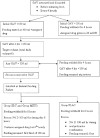Comparison of erythromycin versus metoclopramide for gastric feeding intolerance in patients with traumatic brain injury: A randomized double-blind study
- PMID: 27375386
- PMCID: PMC4916815
- DOI: 10.4103/1658-354X.174902
Comparison of erythromycin versus metoclopramide for gastric feeding intolerance in patients with traumatic brain injury: A randomized double-blind study
Abstract
Background: No randomized controlled trial demonstrates the efficacy of erythromycin or metoclopramide in patients with traumatic brain injury (TBI). This study was conducted to determine the efficacy of metoclopramide and erythromycin for improving gastric aspirate volume (GAV) in patients with TBI.
Materials and methods: Patients with Glasgow coma score more than 5 admitted to trauma Intensive Care Unit within 72 h of head injury were assessed for eligibility. 115 patients were prospectively randomized to receive metoclopramide, erythromycin, or placebo eighth hourly. Gastric feeding intolerance was defined as GAV more than 150 ml with abdominal symptoms. Two consecutive high GAV was defined as feeding failure. Feeding failure was treated by increasing the frequency of dose to 6 hourly in metoclopramide and erythromycin group. Combination therapy with both drugs was given as rescue in the placebo group.
Results: Incidence of high GAV was as high as 60.5% in placebo group. Use of erythromycin was associated with a decrease in the incidence of feeding intolerance to 28.9% (P = 0.006). Although feed intolerance decreased to 43.6% in metoclopramide group, values did not reach statistical significance. The proportion of patients not having high GAV at different days were significantly higher in erythromycin group (P = 0.027, log-rank test). There was no difference in the proportion of patients not having feeding failure in three groups with increasing number of days.
Conclusion: There was a significant decrease in the incidence of high GAV with the use of erythromycin when compared to metoclopramide and placebo.
Keywords: Erythromycin; gastric feeding intolerance; traumatic brain injury.
Figures




References
-
- McClave SA, Martindale RG, Vanek VW, McCarthy M, Roberts P, Taylor B, et al. Guidelines for the Provision and Assessment of Nutrition Support Therapy in the Adult Critically Ill Patient: Society of Critical Care Medicine (SCCM) and American Society for Parenteral and Enteral Nutrition (A.S.P.E.N.) JPEN J Parenter Enteral Nutr. 2009;33:277–316. - PubMed
-
- Kao CH, ChangLai SP, Chieng PU, Yen TC. Gastric emptying in head-injured patients. Am J Gastroenterol. 1998;93:1108–12. - PubMed
-
- Ott L, Annis K, Hatton J, McClain M, Young B. Postpyloric enteral feeding costs for patients with severe head injury: Blind placement, endoscopy, and PEG/J versus TPN. J Neurotrauma. 1999;16:233–42. - PubMed
-
- Kirby DF. As the gut churns: Feeding challenges in the head-injured patient. JPEN J Parenter Enteral Nutr. 1996;20:1–2. - PubMed
-
- Marino LV, Kiratu EM, French S, Nathoo N. To determine the effect of metoclopramide on gastric emptying in severe head injuries: A prospective, randomized, controlled clinical trial. Br J Neurosurg. 2003;17:24–8. - PubMed
LinkOut - more resources
Full Text Sources
Other Literature Sources

